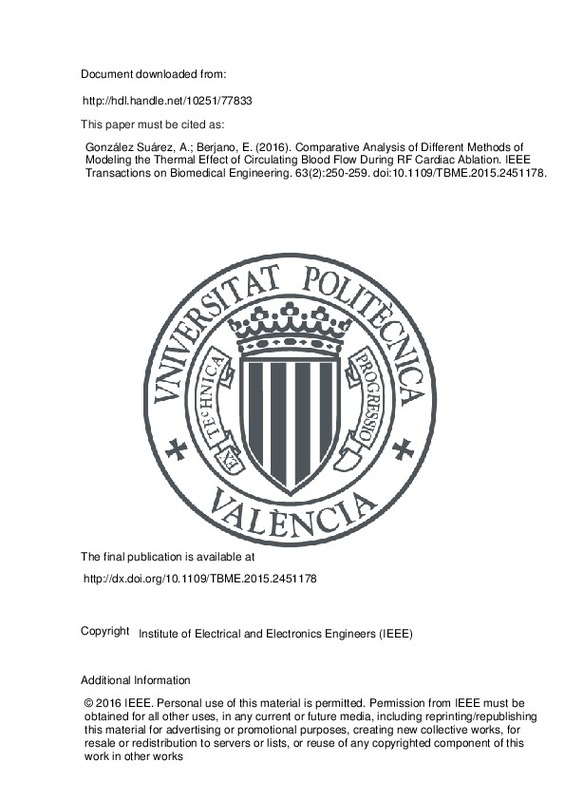JavaScript is disabled for your browser. Some features of this site may not work without it.
Buscar en RiuNet
Listar
Mi cuenta
Estadísticas
Ayuda RiuNet
Admin. UPV
Comparative Analysis of Different Methods of Modeling the Thermal Effect of Circulating Blood Flow During RF Cardiac Ablation
Mostrar el registro sencillo del ítem
Ficheros en el ítem
| dc.contributor.author | González Suárez, Ana
|
es_ES |
| dc.contributor.author | Berjano, Enrique
|
es_ES |
| dc.date.accessioned | 2017-02-10T15:53:51Z | |
| dc.date.available | 2017-02-10T15:53:51Z | |
| dc.date.issued | 2016-02 | |
| dc.identifier.issn | 0018-9294 | |
| dc.identifier.uri | http://hdl.handle.net/10251/77833 | |
| dc.description | © 2016 IEEE. Personal use of this material is permitted. Permission from IEEE must be obtained for all other uses, in any current or future media, including reprinting/republishing this material for advertising or promotional purposes, creating new collective works, for resale or redistribution to servers or lists, or reuse of any copyrighted component of this work in other works | es_ES |
| dc.description.abstract | Our aim was to compare the different methods of modeling the effect of circulating blood flow on the thermal lesion dimensions created by radio frequency (RF) cardiac ablation and on the maximum blood temperature. Computational models were built to study the temperature distributions and lesion dimensions created by a nonirrigated electrode by two RF energy delivery protocols (constant voltage and constant temperature) under high and low blood flow conditions. Four methods of modeling the effect of circulating blood flow on lesion dimensions and temperature distribution were compared. Three of them considered convective coeffi- cients at the electrode–blood and tissue–blood interfaces to model blood flow: 1) without including blood as a part of the domain; 2) constant electrical conductivity of blood; and 3) temperaturedependent electrical conductivity of blood (+2%/°C). Method 4) included blood motion and was considered to be a reference method for comparison purposes. Only Method 4 provided a realistic blood temperature distribution. The other three methods predicted lesion depth values similar to those of the reference method (differences smaller than 1 mm), regardless of ablation mode and blood flow conditions. Considering the aspects of lesion size and maximum temperature reached in blood and tissue, Method 2 seems to be the most suitable alternative to Method 4 in order to reduce the computational complexity. Our findings could have an important implication in future studies of RF cardiac ablation, in particular, in choosing the most suitable method to model the thermal effect of circulating blood. | es_ES |
| dc.description.sponsorship | This work was supported in part by the Spanish "Plan Estatal de Investigacion, Desarrollo e Innovacion Orientada a los Retos de la Sociedad" under Grant TEC2014-52383-C3 (TEC2014-52383-C3-1-R) and also by the Basque Government through the BERC 2014-2017 program and by Spanish Ministry of Economy and Competitiveness MINECO: BCAM Severo Ochoa excellence accreditation SEV-2013-0323. Asterisk indicates corresponding author. | en_EN |
| dc.language | Inglés | es_ES |
| dc.publisher | Institute of Electrical and Electronics Engineers (IEEE) | es_ES |
| dc.relation.ispartof | IEEE Transactions on Biomedical Engineering | es_ES |
| dc.rights | Reserva de todos los derechos | es_ES |
| dc.subject | Blood flow | es_ES |
| dc.subject | Cardiac ablation | es_ES |
| dc.subject | Catheter ablation | es_ES |
| dc.subject | Computer modeling | es_ES |
| dc.subject | Radio frequency (RF) ablation | es_ES |
| dc.subject | Thermal modeling | es_ES |
| dc.subject.classification | TECNOLOGIA ELECTRONICA | es_ES |
| dc.title | Comparative Analysis of Different Methods of Modeling the Thermal Effect of Circulating Blood Flow During RF Cardiac Ablation | es_ES |
| dc.type | Artículo | es_ES |
| dc.identifier.doi | 10.1109/TBME.2015.2451178 | |
| dc.relation.projectID | info:eu-repo/grantAgreement/MINECO//TEC2014-52383-C3-1-R/ES/TECNOLOGIAS BASADAS EN ENERGIA DE RADIOFRECUENCIA Y MICROONDAS PARA CIRUGIA DE MINIMA INVASION/ | es_ES |
| dc.relation.projectID | info:eu-repo/grantAgreement/MINECO//SEV-2013-0323/ES/-/ | es_ES |
| dc.rights.accessRights | Abierto | es_ES |
| dc.contributor.affiliation | Universitat Politècnica de València. Escuela Técnica Superior de Ingeniería del Diseño - Escola Tècnica Superior d'Enginyeria del Disseny | es_ES |
| dc.contributor.affiliation | Universitat Politècnica de València. Departamento de Ingeniería Electrónica - Departament d'Enginyeria Electrònica | es_ES |
| dc.description.bibliographicCitation | González Suárez, A.; Berjano, E. (2016). Comparative Analysis of Different Methods of Modeling the Thermal Effect of Circulating Blood Flow During RF Cardiac Ablation. IEEE Transactions on Biomedical Engineering. 63(2):250-259. https://doi.org/10.1109/TBME.2015.2451178 | es_ES |
| dc.description.accrualMethod | S | es_ES |
| dc.relation.publisherversion | http://dx.doi.org/10.1109/TBME.2015.2451178 | es_ES |
| dc.description.upvformatpinicio | 250 | es_ES |
| dc.description.upvformatpfin | 259 | es_ES |
| dc.type.version | info:eu-repo/semantics/publishedVersion | es_ES |
| dc.description.volume | 63 | es_ES |
| dc.description.issue | 2 | es_ES |
| dc.relation.senia | 311555 | es_ES |
| dc.identifier.eissn | 1558-2531 | |
| dc.contributor.funder | Ministerio de Economía y Competitividad | es_ES |
| dc.contributor.funder | Gobierno Vasco/Eusko Jaurlaritza | es_ES |







![[Cerrado]](/themes/UPV/images/candado.png)

